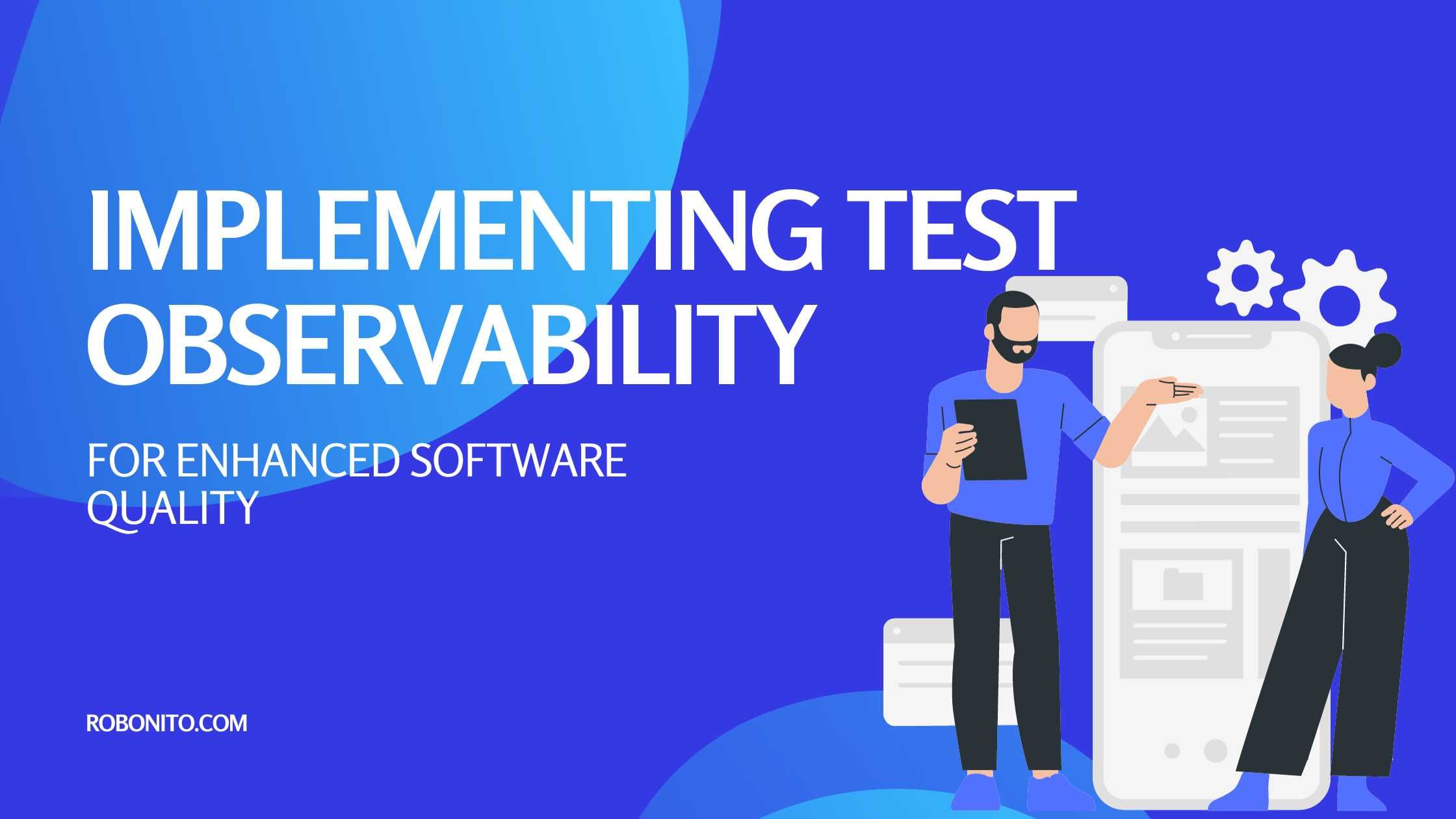Ensuring the quality and reliability of software applications is crucial. Implementing Test observability emerges as a pivotal aspect of software testing, focusing on understanding and monitoring the behavior of tests within a system. This article provides an in-depth exploration of implementing test observability to elevate software quality, discussing its importance, components, implementation strategies, benefits, challenges, and best practices.
Understanding Test Observability

Importance in Software Testing
Test observability significantly influences the effectiveness and success of the software testing process. It enables developers and testers to comprehensively track and analyze tests, providing valuable insights into the system's behavior and performance during testing phases.
Components of Test Observability

Test observability comprises several interconnected components, including logging, instrumentation, metrics collection, and tracing. These components collectively facilitate the capture, analysis, and understanding of test-related data, contributing to a holistic view of the software's behavior.
Logging
Logging involves the systematic recording of events and activities within the software system during the testing phase. Detailed logs aid in understanding the sequence of actions, errors, and issues encountered during testing.
Instrumentation

Instrumentation focuses on embedding monitoring mechanisms within the software code to gather specific performance-related data. It includes inserting code snippets or markers to track and measure various aspects of the software's behavior.
Metrics Collection

Metrics collection involves capturing and analyzing quantitative data related to the software's performance during testing. Key metrics such as response times, error rates, and resource utilization offer critical insights into the system's health and efficiency.
Tracing
Tracing encompasses the ability to follow and analyze the flow of execution across various components of the software system. It helps in understanding the interactions between different modules or services, facilitating better troubleshooting and performance optimization.
Implementing Test Observability in Software Development

Tools and Technologies for Test Observability
Successful implementation of test observability necessitates the utilization of appropriate tools and technologies tailored to capture, analyze, and visualize test-related data effectively.
Prometheus
Prometheus, an open-source monitoring and alerting toolkit, aids in collecting and presenting metrics from various systems. Its flexibility and powerful querying capabilities make it a popular choice for observability solutions.
Grafana
Grafana complements Prometheus by providing visualization capabilities. It allows users to create dashboards and visualize collected data, enabling easier comprehension and analysis of test-related metrics.
Jaeger
Jaeger, an open-source distributed tracing system, assists in monitoring and troubleshooting transactional-based systems. It helps in understanding the flow of requests across multiple services, crucial for complex software architectures.
Strategies for Effective Implementation
Successful implementation of test observability requires a strategic approach encompassing several key strategies.
Clear Testing Objectives
Establishing clear and concise testing objectives ensures that the observability implementation aligns with the overarching goals of the software development process. These objectives guide the selection of appropriate metrics and tools for effective monitoring.
Key Metrics Definition
Defining and prioritizing key metrics relevant to the software's performance goals is essential. Identifying metrics such as response times, error rates, throughput, and resource utilization helps in focusing the observability efforts on critical aspects.
Integration within Testing Infrastructure
Integrating observability mechanisms seamlessly within the testing infrastructure is crucial. This involves embedding monitoring and tracing capabilities into the development and testing processes without disrupting the workflow.
Benefits of Test Observability
Improving Software Quality
Test observability significantly contributes to identifying and rectifying software issues early in the development cycle. By closely monitoring tests and their impact, organizations can detect bugs, performance bottlenecks, and inefficiencies, leading to higher software quality and customer satisfaction.
Enhancing Debugging Capabilities
The detailed insights provided by observability mechanisms simplify the debugging process. Developers can trace and analyze the behavior of tests, pinpointing issues accurately and facilitating quicker resolution, thereby reducing downtimes and enhancing the overall reliability of the software.
Challenges in Implementing Test Observability
Integration Complexity
Implementing observability tools and practices might pose challenges related to integration with existing systems and workflows. Compatibility issues with diverse environments and technologies could hinder seamless integration.
Compatibility Across Environments
Ensuring observability practices are compatible across various development and testing environments, including local setups, staging environments, and production systems, can be challenging. Maintaining consistency and accuracy in data collection across these environments is crucial.
Book a free demo now! and know how @Robonito can reduce your testing time by 98% and reduce your costs.
Establishing Standardized Practices
Establishing standardized practices and methodologies for observability across teams and projects can be daunting. Ensuring uniformity in logging formats, instrumentation techniques, and metrics definitions requires concerted efforts and coordination.
Best Practices for Test Observability
Monitoring Techniques
Employing robust monitoring techniques is essential for effective observability.
Log Aggregation
Aggregating logs from different components of the software system provides a comprehensive view of its behavior. Centralized log management systems aid in storing, analyzing, and visualizing logs for easy troubleshooting.
Real-time Metrics Tracking
Real-time tracking of metrics allows for immediate detection of anomalies or deviations from expected behavior. Setting up alerts based on predefined thresholds helps in proactively addressing issues before they escalate.
Distributed Tracing
Distributed tracing enables tracing the path of requests across multiple services or components. It aids in identifying performance bottlenecks and understanding complex interactions within distributed systems.
Continuous Improvement Methods
Fostering a culture of continuous improvement is crucial for evolving observability practices.
Regular Evaluation
Regularly evaluating and refining observability practices ensures their relevance and effectiveness in addressing evolving software testing requirements.
Collaboration and Knowledge Sharing
Encouraging collaboration among teams and sharing best practices facilitates mutual learning and improvement in observability methodologies.
Conclusion
Implementing test observability stands as a cornerstone for achieving enhanced software quality and reliability. By embracing comprehensive monitoring, analysis, and tracing of tests within software systems, organizations can identify issues early, improve debugging efficiency, and deliver high-quality software that meets user expectations.
Book a free demo now! and know how @Robonito can reduce your testing time by 98% and reduce your costs.
FAQs (Frequently Asked Questions)
-
What does test observability entail in software development? Test observability involves monitoring and analyzing the behavior of tests within a software system to ensure effectiveness and reliability.
-
Why is test observability important in software testing? Test observability aids in early issue detection, efficient debugging, and ultimately, improving the overall quality of software.
-
What challenges are faced in implementing test observability? Challenges include integration complexities, ensuring compatibility across environments, and establishing standardized practices.
-
Which tools are commonly used for test observability? Popular tools include Prometheus, Grafana, and Jaeger, offering functionalities for monitoring, visualization, and tracing of test processes.
-
How does test observability benefit software development? It improves software quality by detecting bugs early and simplifies debugging processes for faster issue resolution.
For further exploration and to delve deeper into the world of test observability, consider accessing additional resources or tools available in the field.
